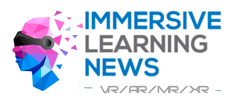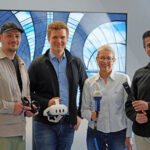Traditional video content can feel static and disconnected, limiting how creators and performers engage with audiences. As immersive digital experiences become more popular – especially among younger audiences who grew up with gaming – there’s a rising demand for deeper, more interactive storytelling.
Volumetric Video is turning the tables with a 360-degree, video-realistic format that captures human presence like never before. From performers to educators, this platform allows creators to immerse their audience in a lifelike, dynamic experience, using just a smartphone and their River application.
Anthony Rose, SeedLegals Co-Founder and CEO, caught up with founder Ed Jenkins to explore how Volumetric Video applies spatial media and how the technology is set to change how we experience content.
The problem with traditional video content
- Audiences today are after interactive, immersive experiences, leaving traditional 2D content feeling flat and disconnected.
- Creators, performers and brands struggle to make their content feel engaging and lifelike.
- There’s a growing need for video formats that go beyond flat screens and static perspectives.
Volumetric’s solution
- Volumetric Video creates 360-degree media that feels dynamic and mimics human presence in a hyperrealistic, three-dimensional way.
- Unlike traditional video, this format lets audiences move around and interact with content, so they get a deeper sense of connection and presence.
- By using advanced capture systems and the River application, Volumetric Video makes it possible to view lifelike performances on any smartphone, from anywhere.
Traction and growth
- With a background in music and entertainment, Ed Jenkins saw firsthand how immersive experiences could transform audience engagement – especially during the pandemic.
- Inspired by creating a virtual reality Glastonbury Festival, Ed pursued building a platform where anyone could experience content in a more lifelike way.
- Backed by Innovate UK and other supporters, Volumetric Video is now partnering with brands, educators and artists to commercialise deeper human connections through spatial media.
- Anthony: Hello I’m Anthony, founder at SeedLegals and every day I meet amazing founders. So today I’m talking to Ed from Volumetric Video. Ed, tell us about yourself.Ed: Hi. Thank you for having me. So Volumetric Video Ltd, we’re helping creators elevate storytelling, by leveraging deeper human connection that’s stimulated by the use of spatial media. And what is spatial media? It’s a 360 degree, video realistic media format that really kind of, yeah, elevates and amplifies the sense of presence from a performance. You know, from a musician or creator or someone educating. So. Yeah, that’s what we’re working on.Anthony: All right. So you got this super fancy iPhone and you create 3D representations of people with just one camera. There’s some awesome technology. Tell us about the 3D.Ed: Well, we’re trialing that, but, primarily at the moment for the higher fidelity and the higher output, we’re using a 360 degree capture system. We are infrastructure agnostic. So, we are able to work with, really kind of deep tech companies that are innovating in the space to bring best practice for 360 degree capture and then converting into 360 degree digital output that you can then watch through our river application on any smartphone device on 4G, 5G, or Wi-Fi.Anthony: Okay, so give me a use case. Is this for me to make an AI 3D version of Anthony? To answer customer questions at night and put myself out of business? Take us through a use case.Ed: I’ve got a really good one for you. So I know that you’re launching in the states. And I know that you’re doing a lot of traveling, but you are, there’s only one Anthony, sadly. So, let’s say you’ve got a keynote that’s come up in San Francisco. You want to present so we can capture you, and then we can create a 360 degree real time presentation video realistic. So it’s got all of your energy, all of your character. We’re not creating an avatar or a cartoon. This is video realism. And that’s really important because a lot of artists and creators, their personal brand and their image, like your good self, is part of the product that they’ve got to sell.Anthony: So I would come into your studio. That’s right. In London. Yeah. With the multi-camera setup.Ed: That’s it.Anthony: And then how’s it projected at the other end?Ed: Well, anyone with the river application that we’ve built. Anthony: Yeah.Ed: Using one of the latest smartphones can open up the application and watch you present in either life size or, nice and small to fit on the desktop, wherever they are in their personal space. And that creates deeper human connection because you have, it’s the next best thing to having Anthony in your living room.Anthony: All right. So in the near future. So today you need a multi-camera setup to capture 3D, but in the near future, thanks to the latest iPhones and so on, they’ve got lidar built in. And so you can create 3D models from people. From the end user watching it, how’s that differing from the video? Can you rotate the model?Ed: This is it, this is it. So when we say sort of a deeper presence, that’s because like, communicating with a human, you can move around. You’re not kind of wedded to a 2D screen. And also, I think what’s interesting for us, and interesting from a storytelling point of view is young people grow up with gaming. They grow up now in immersive environments. They grew up wanting to be part of the story, part of the game, engaging. So the opportunity for us to kind of co-create and create user generated content by having audiences participate with Anthony dancing along stage or lip syncing or doing any of the tropes that are popular on TikTok and Snapchat.But doing it and being part of that content piece and part of that presentation and performance and how we then commercialize those deeper relationships. That’s what we’re trying to do. And we’re at a really interesting stage now where, we’re just about to open, a pilot of a capture studio, with a really big kind of, partner, commercial partner to really kind of bring in brands, to bring in performers, to bring in educators, fashion and, yeah, just work out how we can commercialize this deeper relationship that’s leveraged by the deeper human connection that we get with spatial media. Anthony: Okay. That sounds amazing. And what do you say is the key go-to market for the business. Is it a consumer app that millions of people use to watch it? Is it a pay per motion capture event for brands? Is it for something for, you know, makers to use themselves? Where do you see your main path?Ed: That’s a really good question. At the moment we’re going for consumer and I’m focused really firmly on mobile because the mobile is a computer in your pocket and with lidar, depth sensing technology on on the cameras the opportunity now to have these like really immersive experiences that touch you when you participate in them, it means that you don’t need to buy a different VR headset. I don’t need an expensive gaming computer. And so that sense of scale, the opportunity to reach as many people as possible, the billions who have iPhones in their pocket means that we’ve got some really interesting opportunities for brands to involve themselves in those conversations at scale and really kind of see like an ROI for being part of that storytelling.Anthony: And you see a new world of a kind of augmented reality, VR, 3D, TikTok where all the content you’re watching is in this enhanced depth. Absolutely. And you talked earlier about single points of capture. You know, there are people doing really exciting things out there from a technical engineering point of view where you’re able to create what’s currently called 2.5 D, using a single point of capture and the opportunity then to democratize, to give everybody the means of creating this immersive, unique content and then channeling it through our river application means that, yeah, this is going to be the next big social platform.Anthony: All right. And what’s your background and what got you out of bed one day to go I want to build… Ed: A great question. It’s a really interesting story. So I come from music and entertainment. I was managing some of the world’s biggest electronic music acts going into the pandemic. I was helping to program an area of Glastonbury Festival and, during Glastonbury Festival, we had the opportunity, when it was canceled due to the pandemic, we worked together and created a virtual reality Glastonbury, which is an incredible experience during lockdown. And, really kind of piqued my interest in real culture utilizing these new immersive digital technologies. And that really just sent me down a rabbit hole. And, you know, I’ve been lucky to find some really great backers and supporters, both from the government, innovate UK and other departments like Department of International Trade, who I’m going to South by Southwest with, but also kind of some angel investors who come from gaming, who come from, advertising technology. And together we’re really kind of just laying this roadmap that I hope millions, if not billions, of people are going to go down over the next years. Anthony: That sounds amazing.Ed: It’s a big picture. Anthony: How can people contact you to find out more? Ed: Yeah, LinkedIn I think, is the preeminent way or my email is ed@vol.video. But, come check me out. Edward Jenkins on LinkedIn, because it’s just such a great way to showcase all of the things that are going on, whether it is speaking at academic conferences, going to South by Southwest on the trade mission, and just generally evangelizing about what’s coming down the track. Anthony: Amazing. Ed, it was fabulous talking to you. I’m looking forward to using your tech and product to make that virtual Anthony side and have spent as much time on airplanes. So Ed, thank you so much.Ed: Thank you.
Quelle:
https://seedlegals.com/resources/360-degree-storytelling-with-volumetric-video/


